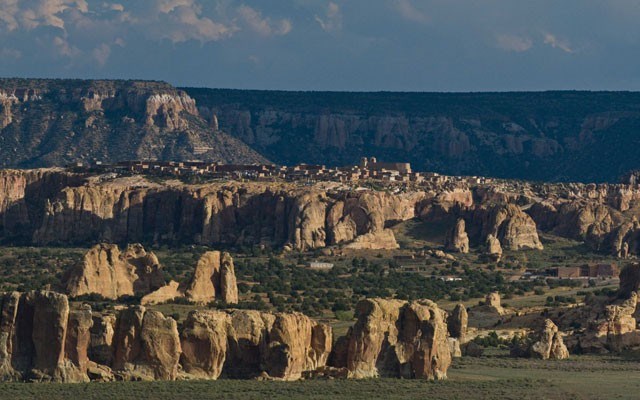It's been around for so long the native word for it simply means "the place that always was." Depending on which estimate you believe, Acoma Pueblo, the oldest continuously inhabited settlement in the U.S., may date back 1,200 years or, as the tribe's oral tradition teaches, 2,000 years. Either way, it makes St. Augustine, Florida, founded in 1565 — and claiming to be the oldest continuously inhabited European-founded settlement in the U.S. — seem almost contemporary.
It sits high atop a mesa in western New Mexico, a flat-topped punctuation in a bone dry, sere desert of iron-rich red rock, pale yellow sandstone, sagebrush and prehistoric remnants of rivers that used to flow. To the west a short distance the sprawling Zuni-Bandera lava flows of El Malpais — the badlands — National Monument create an appropriately surreal border for this most psychedelic of landscapes. One-hundred-and-five kilometres due east, the lights of Albuquerque glow ominously in the night sky.
The Acoma tribe, progeny of the even more ancient Anasazi and Mogollan peoples, have lived here and dry farmed the surrounding lands for at least 1,200 years, living in relative peace with neighbouring Navajo and Apache tribes. The virtually unassailable nature of the Acoma's home provided much of that peace. The only access to the mesa's top, 111 metres above the valley floor, was by a vertiginous staircase — often not much more than foot and hand holds — cut into the rock and almost invisible to the naked eye. The high ground was easy to hold and expensive to gain.
Peace survived the Acoma's first brush with Spanish explorers in 1540. But New Mexico's "founder," Juan de Oñate managed to subjugate the tribe after the Acoma ambushed some of his troops in 1598. Six hundred villagers were killed and 500 more were taken prisoner during the resulting Acoma Massacre and enslaved. Men older than 25 had their right feet amputated to ensure their aquiescence.
Ironically, in 1998, after a statue of Oñate was erected in Rio Arriba county in the far north of New Mexico — a hotbed of Chicano rights activism in the 1960s and '70s — someone chainsawed off the statue's right foot.
The usual miseries were visited on the Acoma people after Spanish conquest: smallpox, religious suppression, taxation, and cultural annihilation, with Catholicism being the only lasting remnant, largely in the form of the impressive San Estavan Del Rey Mission Church, a massive structure that dominates Acoma Pueblo to this day.
The church's three-metre thick walls were constructed of 20,000 tonnes of adobe mud bricks, all transported by Acoma slave labour from the valley below. Massive ponderosa pine pillars were carried from the flanks of Mt. Taylor, 64 kilometres distant to form the roof-supporting vigas. In all, the church, completed in 1641, covers some 1,951 square metres and is the only native-built structure granted National Trust Historic Site designation.
By 1680, the Acoma had rebuilt their community sufficiently to join the Pueblo Revolt, during which a number of Catholic missionaries and Spanish soldiers were hurled off the mesa's top to the rocks below. Violence begat violence and the cycle started up again.
Fast forward to today. The Acoma people still inhabit what's become known as Sky City, their mesa-top enclave. While most of their number live in nearby Acomita, there are always some who live in the traditional, three-storey buildings, whose uppermost floors are accessed by ladder. There is no electricity, no running water, no sewers. Modern composting toilets sit next to portapotties. Depressions in the rock, creating natural cisterns, are still the only indigenous water. Yet, the place seems to veritably thrive.
Forays to Sky City start at a modern visitor centre and museum. Thankfully, the way up is by shuttle bus on a road blasted out in the 1960s. The more intrepid may pick their way down the ancient stone steps on the return trip and doing so drives home the point of just how sheltered — and arduous — life must have been in times long past.
All journeys are guided and guides fascinate with stories from Acoma's rich lore. Opportunities are afforded to linger and speak to residents, modern potters that soft-sell ancient vessels bearing distinct, Acoma geometric designs. The old sit comfortably alongside more modern crafts bordering on kitsch. With a permit, acquired at the visitor centre, you can take still photos but the joy lies in talking to the artisans about life at the top of the world.
You can feel hundreds of years of struggle and salvation within the walls of the old church. The struggle of the New World against Old lies — as do some of the former inhabitants — within the thick, cool, adobe walls.
Acoma is simply one of those places that will reboot your relationship with time, history and your place in the world.




